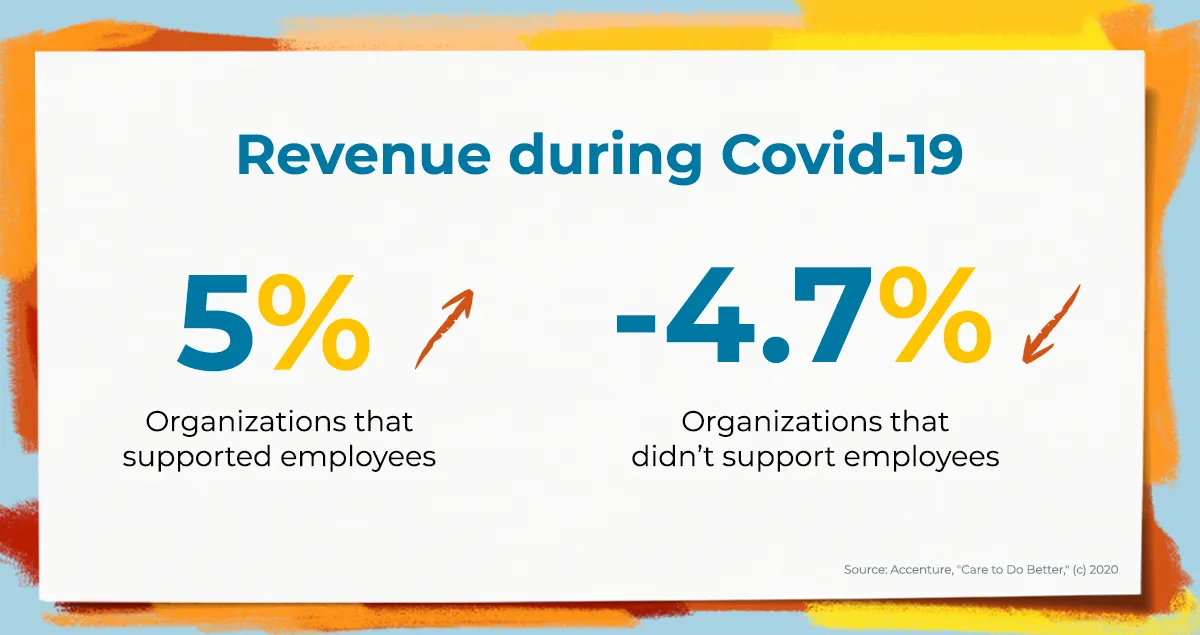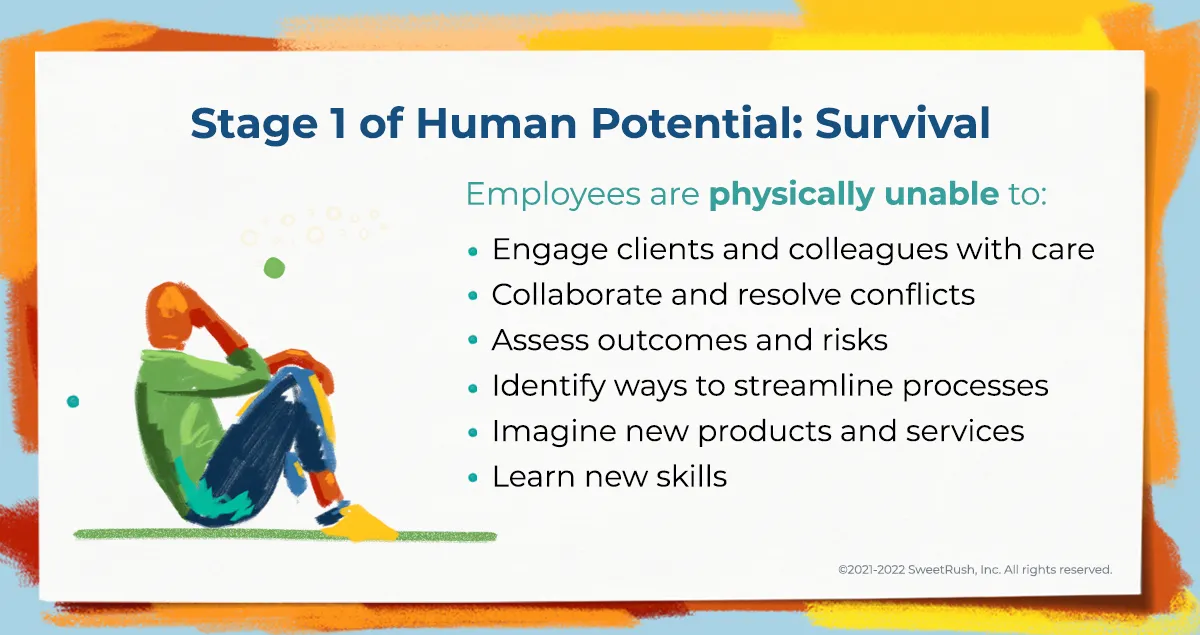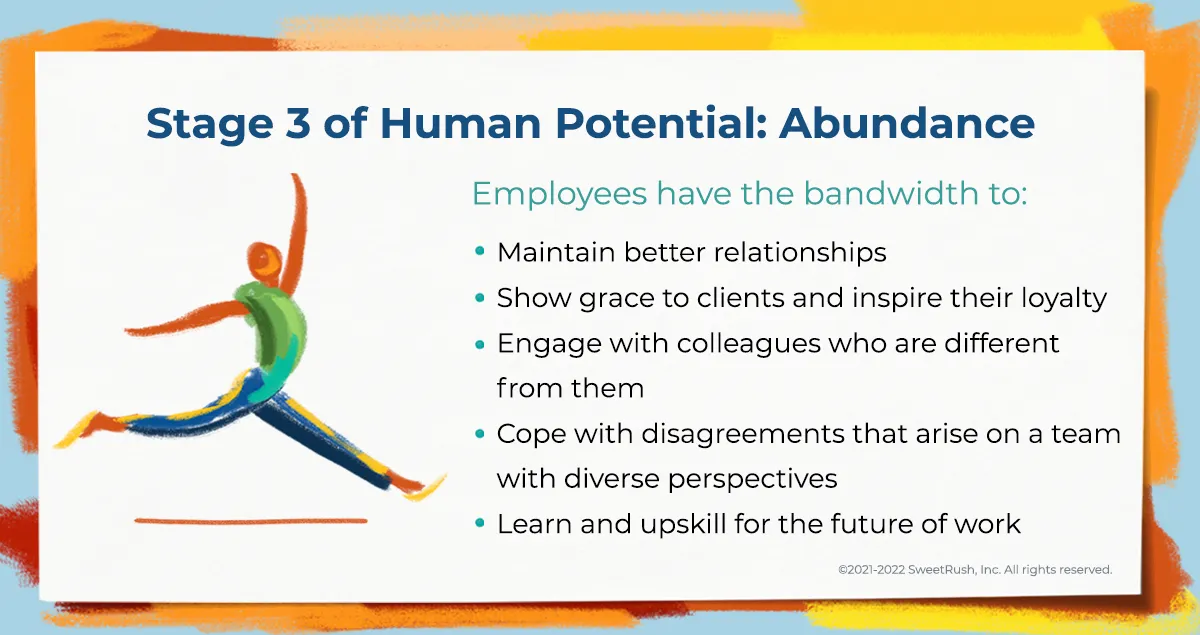
If there’s one thing the pandemic has taught us about ourselves, it’s that the problem of any human is the problem of all humans.
And we humans have more problems ahead. Hardships due to climate change, social unrest and, yes, the next pandemic—everything hiding in the fine print of our insurance policies—will become increasingly common.
We need to plan now to prevent the reactive decisions of our future fear brains. And we need to heal the accumulated pain1 of the past year and a half.
Some 41% of our employees are burned out.2 Over five million women—and counting—have left the U.S. workforce, and women of color are disproportionately represented in that number.3
That’s not just a talent drain; it’s a major systemic failure. The pandemic may be the straw that broke so many workers, but work hasn’t been working for a long time.
This Harvard Business Review headline says it all: “Employee Burnout Is a Problem with the Company, Not the Person.”4 And that was back in 2017.
About one in three forward-thinking leaders, according to Accenture,5 has always understood that supporting the “care and resilience of human workers” goes hand in hand with profits.
By September 2020, 50% of CEOs had come around. Organizations that supported employees across six mental, physical, social, and financial health measures grew their revenue by over 5%. And that’s during the financial and market turbulence of the past 18 months. And now, their businesses are reaping the rewards.
How did the other half do?
They suffered a revenue decline to the tune of -4.7%.5

We won’t call it karma, but there is a direct correlation between doing good and doing well. And doing good begins with the smallest unit of organizational culture: a single employee.
Like every living thing, humans need abundance and freedom from suffering. When we have those, we have the energy and bandwidth to immerse ourselves in our craft, grow, and innovate. If we’re stuck in survival mode, we can’t engage in this deep work.
Models like Maslow’s hierarchy of needs;6 Graves, Beck, and Cowan's Spiral Dynamics;7 and even Kohlberg’s stages of moral development8 illustrate how meeting these conditions help us develop to our full moral, intellectual, and creative potential. We’ve simplified these models into three stages of human potential.
As you read, consider which stage your organization enables employees to meet—and how you might join that thriving 50% of leaders concerned with the care and resilience of their human workers.5

An organization that keeps employees in a Stage 1 state via low wages, an authoritarian culture, and lack of autonomy will never see them at their best. Under these conditions of scarcity and insecurity, the fight-or-flight parts of the brain take control—and make it physicallyimpossible to perform tasks like critical thinking, problem-solving, and even impulse control.
Stage 1 living has a price: a “cognitive tax” of the equivalent of 13 or 14 IQ points.9 That’s a tremendous loss for the individual, who might never get to demonstrate (or discover!) their dormant creativity and skills. It’s also a loss for the business: Employees hamstrung at Stage 1 have little bandwidth to perform the vital tasks listed above.
And if an enterprising employee does identify a way to go above and beyond? They might share it—once. But their organizations aren’t really looking for new ideas, at least not from the people on the front lines.
Sooner or later, employees get the message: thinking and creativity are above their pay grade. They learn to ration their energy and give the absolute minimum while they’re on the clock.

An organization that offers employees a Stage 2 existence pays them well enough to live in relative security. With their basic needs met, employees have some free time to engage in family activities, hobbies, and home maintenance. At work, they have sufficient bandwidth to solve problems, meet deadlines, and (usually!) engage others.
Their work conditions span a wide range, from rigid to slightly more accommodating, and employees at Stage 2 find themselves wishing for more autonomy and trust. They wonder, Why do I have to spend an hour in traffic just so my boss sees me at my desk? Why do I need to ask permission to go to a dentist appointment?
Any flexibility that is offered tends to be on an ad hoc basis. Under extenuating circumstances, or by the grace of a supervisor, some employees get permission to work from home “just this once” when the kids are sick or the car won’t start. Others are told to use PTO.
Because asking for special treatment activates the fearful Stage 1 brain, this lack of flexibility adds a cognitive tax. Even the daily crunch of trying to fit it all in—from dropping off the kids in the morning to the overdue checkup—drops the Stage 2 individual down a notch. And in Stage 1 mode, everyone is more likely to be short with a client or overlook an error on a project.
Their organizations tend to reward good work and punish the bad—and the fear of consequences can make Stage 2 employees reluctant to take risks. They care about their work, but they want projects off their plates and on to the next person as quickly as possible.
Going above and beyond is too risky. In the process, their organizations lose out on innovation—and the ability to learn and grow.

At Stage 3, organizations meet employees’ needs—and then some. Wages provide the abundance to cover aspirational items such as education, hobbies, and travel. At work, Stage 3 employees apply creativity to problems and draw connections between their work and the organizational mission. They have better relationships—and longer fuses.
Remember that autonomy and trust our Stage 2 friends only dream of? These folks have it. Stage 3 employees have full autonomy as to when, where, and how they work. Need to meet across time zones? Shift work hours? Cover time off? Stage 3 employees figure it out with their teams—no permission asked or granted.
Because everyone is equally special, there’s no such thing as special treatment: the organization never scares anyone back to Stage 1. But life can. We all have experiences—good and bad—that derail our capacity to reason and express ourselves. When these befall the Stage 3 employee, leaders and colleagues offer their immediate support and empathy.
Empathy isn’t just for the tough times either: Stage 3 organizations don’t punish their people for making mistakes. Managers recognize failure as human—and a natural by-product of pursuing big, hairy, audacious ideas—and stress the importance of learning from them. Failure doesn’t knock a Stage 3 employee back to Stage 1 because it’s not an existential threat—as long as the lesson is learned and owned.
A group of Stage 3 individuals working toward a shared mission is a happy, powerful bunch. And they’re loyal to the organization that helps them live a good life, reducing costly turnover.10
Still feeling hesitant about offering employees the degree of flexibility and autonomy that helps them operate at Stage 3?
Consider this: You already know that your company is public-facing and accountable to a very online global audience. But you should also know that every part of your product, practice, and pipeline impacts human and nonhuman lives around the world. And it’s your business to make those lives better.
Of course, the need to do good often feels less immediate when the bottom line is looming. But we humans are wired for empathy, and if we could see all of the people our business connects us to, we couldn’t help caring for them. When we provide abundance for one of those lives, we lift up many lives.
And, as those 50% of CEOs who make the “care and resilience of human workers” their business have discovered,5 we also secure near- and long-term abundance for our organizations. Doing good is one of the most solid succession plans we can make—and it’s one that’s readily available to all of us.
Want to ramp every employee up to Stage 3? Our eBook It’s All About Your People!: Embracing Human-Centered Business, Workplace Culture, and Learning Design will show you how to re-create work as a source of resilience and growth. It’s a curated collection of the best mindsets, practices, and lessons from our two decades together as a human-centered organization—and decade-plus as a fully remote team. Whether you’re a leader, a manager, or an individual contributor, you’ll find plenty of proven steps you can take today (or anytime!) to create a workplace that helps your people thrive.
References